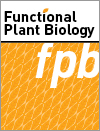Bioinformatics analysis showed associations between Calvin cycle and photorespiration pathways’ key genes. Some microRNAs were identified as post-transcriptional regulators in rapeseed (Brassica napus). The methanol foliar application enhanced plant tolerance under drought stress.

Functional Plant Biology
Volume 51 Number 3 2024
Plants, as sessile, have developed a series of mechanisms to adapt the environmental stresses, which was regulated by a cascade of genes and transcriptional factors. Here, we analysed the gene function of MsKMS1 in seed germination of transgenic tobacco (Nicotiana tabacum) under abiotic stress conditions and found that MsKMS1 negatively affected seed germination by increasing ABA and salicylic acid contents, regulating the expression of genes related to ABA and GA biosynthesis.
Orchid (Phalaenopsis spp.) is a most popular flowering potted plant. However, it has been poorly studied at the physiological and molecular level. The bulky aerial roots of Phalaenopsis have a large diameter and are possibly photosynthetically active. Here, we present evidence demonstrating that root photosynthesis prevents hypoxia in the root tissue. Our results support the existence of hypoxic niches in plant roots and highlight the existence of mechanisms to modulate the intensity of hypoxia.
This article belongs to the Collection Flooding Stress and Hypoxic Responses in Plants.
FP23227 Abstract | FP23227 Full Text | FP23227PDF (1.9 MB) | FP23227Supplementary Material (818 KB) Open Access Article
Quinoa (Chenopodium quinoa) produces nutritious and gluten-free grains with a fine balance between carbohydrates, essential amino acids, oils, minerals, vitamins, and dietary fibres. The transcription factors (TFs) are the proteins regulating rate of transcription of genetic information from DNA to messenger RNA. The R2R3-MYB transcription factors are the largest subfamily of the MYB family in plants, whereas the numbers of 4R-MYB and 3R-MYB genes are relatively small. In this study, we identified 103 poplar R2R3-MYB transcription factor genes.
This article belongs to the Collection Functional Genomics for Developing Climate Resilient Crops.
Black-grass is a problematic weed of winter wheat. To better understand if waterlogging tolerance increases its weediness, we conducted controlled waterlogging studies comparing the physiology and molecular responses of black-grass and wheat. These revealed differences in roots and aerial tissues within and between species. Molecular analyses showed that wheat mounts a significant molecular response, altering gene expression and metabolites with waterlogging, whereas black-grass showed minimal responses to waterlogging despite its apparent tolerance.
This article belongs to the Collection Flooding Stress and Hypoxic Responses in Plants.
FP23193 Abstract | FP23193 Full Text | FP23193PDF (8 MB) | FP23193Supplementary Material (25.1 MB) Open Access Article
The extremophile Salicornia europaea is characterised for its tolerance to high salt and flooding conditions. Here, we studied the effect of multiple and simultaneous environmental perturbations of salinity and waterlogging on its growth. Responses to salt and hypoxia reciprocally affected each other when applied simultaneously, demonstrating the significance to investigate signalling-crosstalk between environmental stress reactions in tolerant species.
This article belongs to the Collection Flooding Stress and Hypoxic Responses in Plants.
FP23228 Abstract | FP23228 Full Text | FP23228PDF (2.4 MB) | FP23228Supplementary Material (806 KB) Open Access Article
Cross-talk between photosynthesis, fatty acids, starch and sucrose metabolism under multiple stress conditions were highlighted by network analysis of meta genes in Dunaliella tertiolecta. Coordinated expression of the tetrapyrrole intermediated were observed. Vitamin B6 metabolism, ribosome biogenesis and folate biosynthesis specifically responded to different stress conditions.
The specific impact of elevated CO2 on metabolic pathways in wheat (Triticum spp.) organs other than leaves is poorly documented. We addressed this aspect by taking advantage of a free-air CO2 enrichment experiment in durum wheat (Triticum durum). We found changes in polyamine and cytokinin metabolism under elevated CO2 in glumes and awns but no modifications in final composition at maturity. Elevated CO2 mostly impacts on leaf metabolism but has little effect on glumes and awns.
The pigeon pea (Cajanus cajan) is a diploid legume, grown in humid and subtropic regions around the world. The gene family of Squamosa Promoter-binding like Proteins has been studied in different plant species, but is not yet fully explored in pigeon pea. The identified genes were classified into nine groups based on a phylogenetic analysis. Gene expression analysis using RNA sequencing revealed that CcSPL2.1, 3 and 13A were significantly upregulated in salt-tolerant cultivars, which could be further explored.
This article belongs to the Collection Functional Genomics for Developing Climate Resilient Crops.
Melatonin, as an exogenous hormone, has been widely used in improving plant stress resistance. This paper systematically describes how melatonin improves the ability of plants to resist water stress (drought and waterlogging) in the processes of photosynthesis, antioxidation and osmosis at the physiological and genetic levels. Melatonin can also improve plant stress resistance with other hormone crosstalk, which has high application value.
Environmental constraints like salinity and drought hinder plant growth by affecting plant morphology, physiology, biochemistry, and molecular processes, final crop productivity and threat to global food security. Researches on plant responses to salinity and drought stress is ongoing worldwide. Novel breeding strategies are being adopted due to their short-term impact on agriculture. Given agriculture’s current challenges, we must consider how to effectively transfer laboratory knowledge to the field to mitigate these challenges. This collection discusses plant responses to drought and salinity.
This article belongs to the Collection Understanding the Mechanistic Basis of Plant Adaptation to Salinity and Drought.




